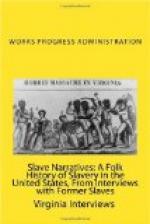Edited By:
John N. Booth
Federal Writers’ Project
WPA Residency No. 7
“Aunt” Easter Brown, 78 years old, was sweeping chips into a basket out in front of her cabin. “Go right in honey, I’se comin’ soon as I git some chips for my fire. Does I lak to talk ’bout when I wuz a chile? I sho does. I warn’t but 4 years old when de war wuz over, but I knows all ’bout it.”
“I wuz born in Floyd County sometime in October. My pa wuz Erwin and my ma wuz Liza Lorie. I don’t know whar dey come from, but I knows dey wuz from way down de country somewhars. Dere wuz six of us chilluns. All of us wuz sold. Yessum, I wuz sold too. My oldest brother wuz named Jim. I don’t riccolec’ de others, dey wuz all sold off to diffunt parts of de country, and us never heared from ’em no more. My brother, my pa and me wuz sold on de block in Rome, Georgia. Marster Frank Glenn buyed me. I wuz so little dat when dey bid me off, dey had to hold me up so folkses could see me. I don’t ’member my real ma and pa, and I called Marster ‘pa’ an’ Mist’ess ‘ma’, ’til I wuz ’bout ’leven years old.
“I don’t know much ’bout slave quarters, or what dey had in ’em, ’cause I wuz raised in de house wid de white folkses. I does know beds in de quarters wuz lak shelves. Holes wuz bored in de side of de house, two in de wall and de floor, and poles runnin’ from de wall and de floor, fastened together wid pegs; on ’em dey put planks, and cross de foot of de bed dey put a plank to hold de straw and keep de little ’uns from fallin’ out.
“What did us have to eat? Lordy mussy! Mist’ess! us had everything. Summertime dere wuz beans, cabbage, squashes, irish ’tatoes, roas’en ears, ’matoes, cucumbers, cornbread, and fat meat, but de Nigger boys, dey wuz plum fools ’bout hog head. In winter dey et sweet ’tatoes, collards, turnips and sich, but I et lak de white folkses. I sho does lak ’possums and rabbits. Yessum, some of de slaves had gyardens, some of ’em sholy did.
“No’m, us Niggers never wore no clothes in summer, I means us little ’uns. In de winter us wore cotton clothes, but us went barefoots. My uncle Sam and some of de other Niggers went ’bout wid dey foots popped open from de cold. Marster had 110 slaves on his plantation.
“Mist’ess wuz good to me. Pa begged her to buy me, ’cause she wuz his young Mist’ess and he knowed she would be good to me, but Marster wuz real cruel. He’d beat his hoss down on his knees and he kilt one of ’em. He whupped de Niggers when dey didn’t do right. Niggers is lak dis; dey wuz brought to dis here land wild as bucks, and dey is lak chicken roosters in a pen. You just have to make ’em ’have deyselves. Its lak dat now; if dey’d ’have deyselves, white folkses would let ’em be.
“Dere warn’t no jails in dem days. Dey had a gyuard house what dey whupped ’em in, and Mondays and Tuesdays wuz set aside for de whuppin’s, when de Niggers what had done wrong got so many lashes, ‘cordin’ to what devilment dey had been doin’. De overseer didn’t do de whuppin’, Marster done dat. Dem patterrollers wuz sompin else. Mankind! If dey ketched a Nigger out atter dark widout no pass dey’d most nigh tear de hide offen his back.




